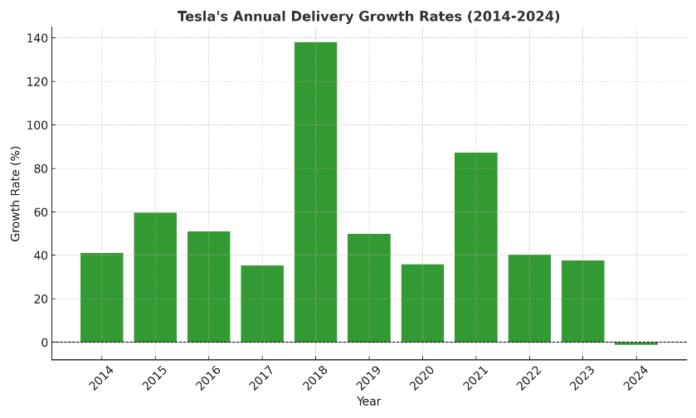Tesla has reported its first-ever yearly drop in deliveries for 2024 due to several factors that collectively dampened demand for its electric vehicles (EVs), Reuters news report said.
Tesla said on Thursday it handed over 471,930 Model 3 and Model Y vehicles and 23,640 units of other models, including the Model S sedan, Cybertruck and Model X premium SUV. Tesla is yet to disclose the delivery numbers for its Cybertruck.
Overall, Tesla delivered 495,570 vehicles in the three months to Dec. 31. It produced 459,445 vehicles in the period, down about 7 percent from a year earlier.
High Borrowing Costs: Rising interest rates made car financing more expensive, discouraging potential buyers from purchasing Tesla’s relatively high-priced vehicles.
Aging Vehicle Lineup: Tesla’s existing lineup, including the popular Model 3 and Model Y, appears to be nearing market saturation, reducing their appeal even with year-end incentives like interest-free financing and free charging.
Reduced Incentives and Policy Shifts:
In Europe, reduced subsidies for EVs affected Tesla’s sales performance.
In the U.S., a shift toward more affordable hybrid vehicles and speculation about the potential removal of the $7,500 EV tax credit under the incoming administration added pressure.
Intensifying Competition:
Tesla faced stiff competition, particularly from China’s BYD, which achieved a 12.1 percent rise in battery-electric vehicle sales in 2024, offering more competitive prices and expanding aggressively in Asian and European markets.
In Europe, Tesla’s registrations fell significantly, with competitors like Volkswagen surpassing Tesla’s sales with models like the Skoda Enyaq.
Cybertruck Demand Concerns: Despite the much-anticipated launch of the Cybertruck, demand for the model has shown signs of weakness. Tesla has yet to disclose detailed delivery figures for the truck.
Operational Challenges: Tesla’s Q4 production was down 7 percent year-over-year, reflecting possible supply chain issues or adjustments in production planning.
Market Saturation: Analysts noted that the current lineup is nearing market saturation, and Tesla may need to rely on newer models and innovations to sustain growth.
Despite these challenges, Tesla performed well in China, its second-largest market, with record-high sales in 2024 due to extended discounts and strong demand. However, its global delivery numbers fell short of analysts’ expectations, with Tesla delivering 1.79 million vehicles in 2024—a 1.1 percent decline from the previous year.
Looking ahead, Tesla’s growth will likely depend on the success of the Cybertruck, promised cheaper versions of its vehicles, and progress in self-driving technology.

